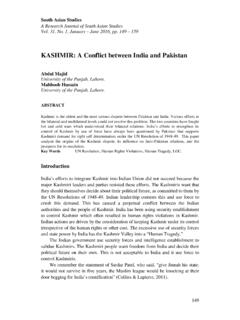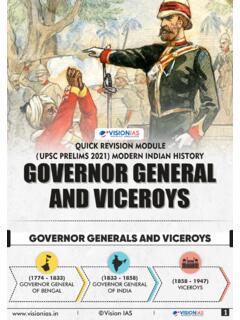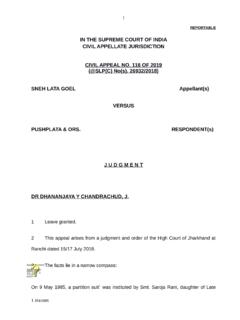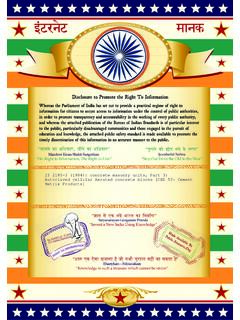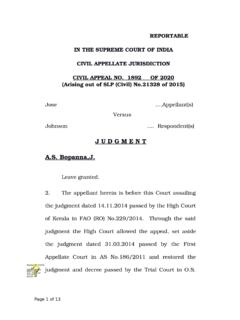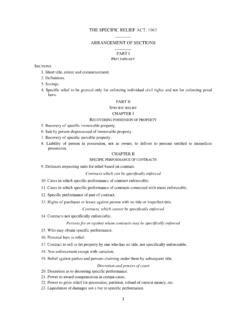Transcription of © NCERT
1 141 THE MAKING OF THE NATIONAL MOVEMENT: 1870S-1947 The Making of the NationalMovement: 1870s--194711In the previous chapters we have looked at: The British conquest of territories, and takeoverof kingdoms Introduction of new laws and administrativeinstitutions Changes in the lives of peasants and tribals Educational changes in the nineteenth century Debates regarding the condition of women Challenges to the caste system Social and religious reform The revolt of 1857 and its aftermath The decline of crafts and growth of industriesOn the basis of what you have read about theseissues, do you think Indians were discontented withBritish rule? If so, how were different groups and classesdissatisfied?Fig. 1 Police teargasdemonstrators during theQuit india movement NCERTnot to be republishedOUR PASTS III142 The Emergence of NationalismThe above-mentioned developments led the people toask a crucial question: what is this country of Indiaand for whom is it meant?
2 The answer that graduallyemerged was: india was the people of india all thepeople irrespective of class, colour, caste, creed, language,or gender. And the country, its resources and systems,were meant for all of them. With this answer came theawareness that the British were exercising control overthe resources of india and the lives of its people, anduntil this control was ended india could not be for consciousness began to be clearly stated by thepolitical associations formed after 1850, especially thosethat came into being in the 1870s and 1880s. Most ofthese were led by English-educated professionals suchas lawyers. The more important ones were the PoonaSarvajanik Sabha, the Indian Association, the MadrasMahajan Sabha, the Bombay Presidency Association,and of course the Indian National the name, Poona Sarvajanik Sabha . The literalmeaning of sarvajanik is of or for all the people (sarva =all + janik = of the people).
3 Though many of theseassociations functioned in specific parts of the country,their goals were stated as the goals of all the peopleof india , not those of any one region, community orclass. They worked with the idea that the people shouldbe sovereign a modern consciousness and a keyfeature of nationalism. In other words, they believedthat the Indian people should be empowered to takedecisions regarding their dissatisfaction with British rule intensified inthe 1870s and 1880s. The Arms Act was passed in 1878,disallowing Indians from possessing arms. In thesame year the Vernacular Press Act was also enactedin an effort to silence those who were critical of thegovernment. The Act allowed the government toconfiscate the assets of newspapers including theirprinting presses if the newspapers published anythingthat was found objectionable.
4 In 1883, there was afurore over the attempt by the government to introducethe Ilbert Bill. The bill provided for the trial of Britishor European persons by Indians, and sought equalitybetween British and Indian judges in the country. Butwhen white opposition forced the government towithdraw the bill, Indians were enraged. The eventhighlighted the racial attitudes of the British in The capacityto act independentlywithout outsideinterference NCERTnot to be republished143 THE MAKING OF THE NATIONAL MOVEMENT: 1870S-1947 The need for an all- india organisation of educatedIndians had been felt since 1880, but the Ilbert Billcontroversy deepened this desire. The Indian NationalCongress was established when 72 delegates from allover the country met at Bombay in December early leadership Dadabhai Naoroji, PherozeshahMehta, Badruddin Tyabji, Bonnerji, SurendranathBanerji, Romesh Chandra Dutt, S.
5 Subramania Iyer,among others was largely from Bombay and , a businessman and publicist settled in London,and for a time member of the British Parliament, guidedthe younger nationalists. A retired British official, Hume, also played a part in bringing Indians fromthe various regions Someonewho publicises an ideaby circulatinginformation, writingreports, speaking atmeetingsWho did the Congressseek to speak for?A newspaper, The Indian Mirror, wrote in January 1886:The First National Congress at Bombay .. is the nucleusof a future Parliament for our country, and will lead tothe good of inconceivable magnitude for our Tyabji addressed the Congress as Presidentin 1887 thus:this Congress is composed of the representatives, notof any one class or community of india , but of all thedifferent communities of nation in the makingIt has often been said that the Congress in the firsttwenty years was moderate in its objectives andmethods.
6 During this period it demanded a greater voicefor Indians in the government and in wanted the Legislative Councils to be made morerepresentative, given more power, and introduced inprovinces where none existed. It demanded that Indiansbe placed in high positions in the government. For thispurpose it called for civil service examinations to beheld in india as well, not just in demand for Indianisation of the administrationwas part of a movement against racisim, since mostimportant jobs at the time were monopolised by whiteActivityFrom the beginning theCongress sought tospeak for, and in thename of, all the Indianpeople. Why did itchoose to do so?hFig. 2 Dadabhai NaorojiNaoroji s book Poverty andUn-British Rule in india offereda scathing criticism of theeconomic impact of British 1 NCERTnot to be republishedOUR PASTS III144officials, and the British generally assumed that Indianscould not be given positions of responsibility.
7 SinceBritish officers were sending a major part of their largesalaries home, Indianisation, it was hoped, would alsoreduce the drain of wealth to England. Other demandsincluded the separation of the judiciary from theexecutive, the repeal of the Arms Act and the freedomof speech and early Congress also raised a number of economicissues. It declared that British rule had led to poverty andfamines: increase in the land revenue had impoverishedpeasants and zamindars, and exports of grains to Europehad created food shortages. The Congress demandedreduction of revenue, cut in military expenditure, andmore funds for irrigation. It passed many resolutionson the salt tax, treatment of Indian labourers abroad,and the sufferings of forest dwellers caused by aninterfering forest administration. All this shows thatdespite being a body of the educated elite, the Congressdid not talk only on behalf of professional groups,zamindars or Moderate leaders wanted to develop publicawareness about the unjust nature of British rule.
8 Theypublished newspapers, wrote articles, and showedhow British rule was leading to the economic ruinof the country. They criticised British rule in theirspeeches and sent representatives to different partsof the country to mobilise public opinion. They feltthat the British had respect for the ideals of freedomand justice, and so they would accept the just demandsof Indians. What was necessary, therefore, was toexpress these demands, and make the government awareof the feelings of Indians. Freedom is our birthright By the 1890s many Indians began to raise questionsabout the political style of the Congress. In Bengal,Maharashtra and Punjab, leaders such as BepinChandra Pal, Bal Gangadhar Tilak and Lala Lajpat Raiwere beginning to explore more radical objectivesand methods. They criticised the Moderates for their politics of prayers , and emphasised the importance ofself-reliance and constructive work.
9 They argued thatpeople must rely on their own strength, not on the good intentions of the government; people must fight forswaraj. Tilak raised the slogan, Freedom is mybirthright and I shall have it! In pursuit of goldThis is what a Moderateleader, Dinshaw Wacha,wrote to Naoroji in 1887:Pherozeshah isnowadays too busywith his personalwork .. They arealready rich Mr. Telang tooremains busy. Iwonder how if allremain busy in thepursuit of gold canthe progress of thecountry be advanced?Repeal To undo law;to officially end thevalidity of somethingsuch as a lawSource 2 ActivityWhat problemsregarding the earlyCongress does thiscomment highlight?h NCERTnot to be republished145 THE MAKING OF THE NATIONAL MOVEMENT: 1870S-1947In 1905 Viceroy Curzon partitionedBengal. At that time Bengal was thebiggest province of British india andincluded Bihar and parts of Orissa.
10 TheBritish argued for dividing Bengal forreasons of administrative convenience. Butwhat did administrative convenience mean? Whose convenience did it represent?Clearly, it was closely tied to the interestsof British officials and businessmen. Evenso, instead of removing the non-Bengaliareas from the province, the governmentseparated East Bengal and merged it withAssam. Perhaps the main British motives wereto curtail the influence of Bengali politiciansand to split the Bengali partition of Bengal infuriated peopleall over india . All sections of the Congress the Moderates and the Radicals, asthey may be called opposed it. Largepublic meetings and demonstrations wereorganised and novel methods of mass protest struggle that unfolded came to be known as theSwadeshi movement, strongest in Bengal but withechoes elsewhere too in deltaic Andhra for instance,it was known as the Vandemataram 3 Balgangadhar TilakNotice the name of the newspaperthat lies on the table.










